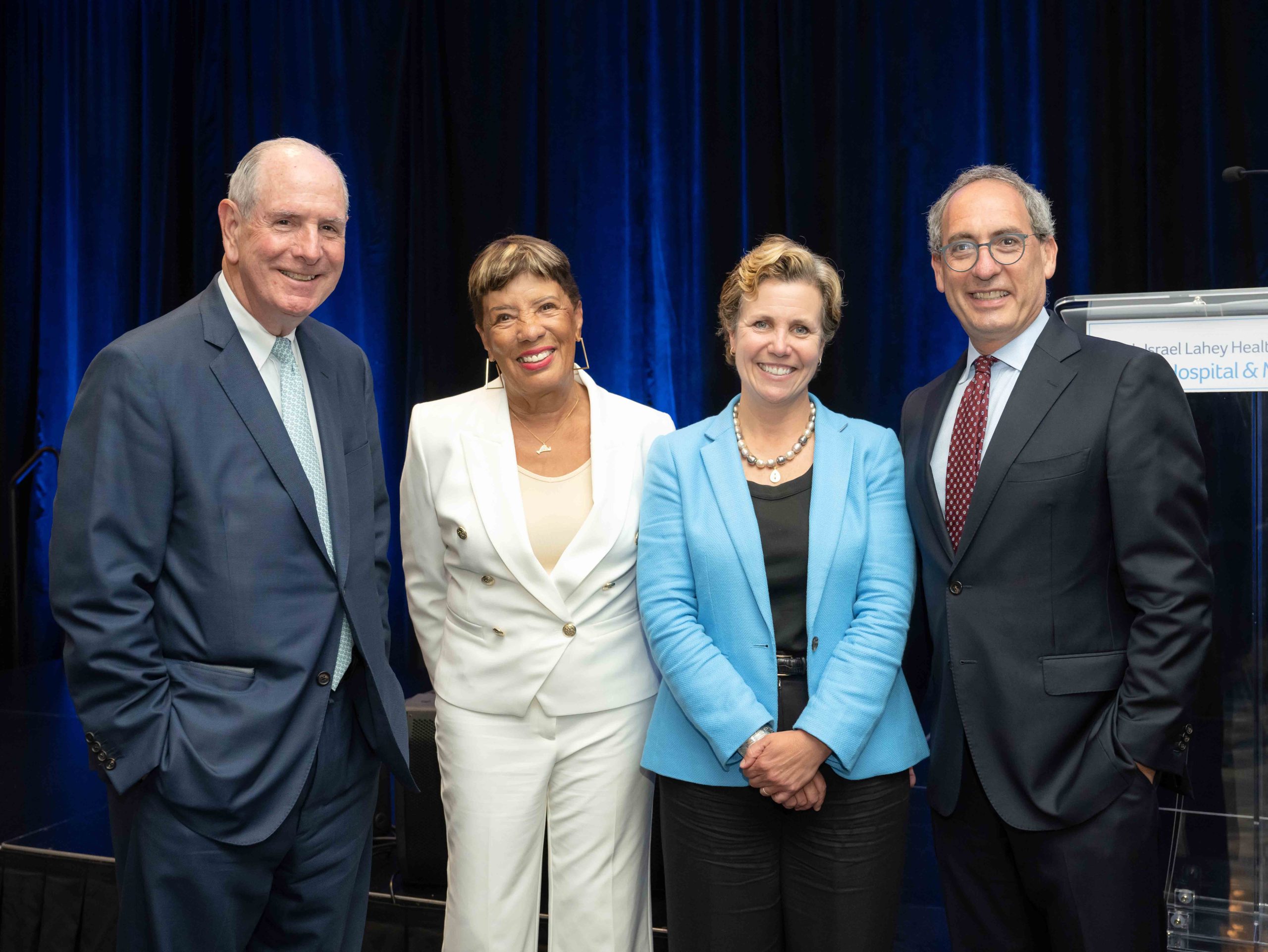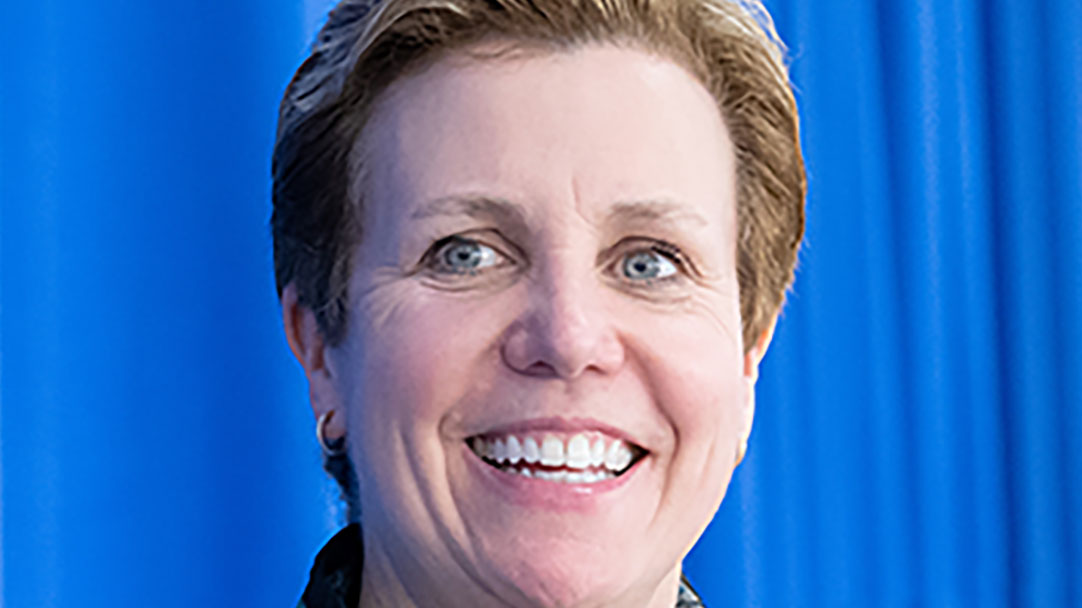
From left to right: UMass Chan Medical School Chancellor Michael F. Collins, MD; Lahey Board of Trustees Chair Jane C. Edmonds; Lahey President Susan-Moffatt Bruce, MD, PhD; and BILH President and CEO Kevin Tabb, MD
Meet Susan Moffatt-Bruce, MD, PhD
New President discusses Lahey’s future
On March 1, the Lahey Hospital & Medical Center community welcomed Susan Moffatt-Bruce, MD, PhD, as President. An accomplished cardiothoracic surgeon and research scientist, she previously served as Chief Executive Officer of the Royal College of Physicians and Surgeons of Canada. Moffatt-Bruce brings decades of healthcare leadership experience from previous roles at Royal College International, the University of Ottawa, and the Ohio State University Wexner Medical Center.
Recognized as an inclusive, transparent, and conscientious leader, she prioritizes the needs of team members and patients above all else. We sat down with her to learn more about Lahey’s culture, her vision for the future, and the role of philanthropy.
What initially drew you to healthcare?
I think my upbringing: my mother was a nurse, and my father is a policeman. They’re both service oriented. I truly believe in service above self. That’s why we are here every day—to continue to improve people’s lives. As a servant leader, I am deeply aware of my responsibility to listen, learn, and foster growth across Lahey.
Tell us about your first few months. How would you describe the Lahey community?
It’s been wonderful to get to know everyone and to begin to really understand the Lahey culture. There are so many great opportunities here. We have a remarkably strong foundation. The deep commitment to patient safety, great outcomes, and provider wellness can be felt throughout the organization.
Lahey is all about the people. Those who provide care every day, those behind the scenes, and those who are part of the governance. We’re fortunate because their commitment to our mission is palpable. From our board members to donors to staff who are here every day taking care of patients—everyone is incredibly engaged. Some employees drive for hours to get to work, and they come with their whole hearts, ready to provide the highest quality of care. This all speaks to a culture of truly being caring, committed, and compassionate.
Which elements from your prior professional experiences have prepared you for your role here?
I think every role prepares you for the next one. I was fortunate to be the inaugural Chief Quality and Patient Safety Officer at The Ohio State University Medical Center. From that, I learned how to build teams and the importance of continuous improvement. I very much understood the need for measuring how well we’re doing and using data to inform decisions. That role was absolutely pivotal.
I’m fortunate that I’ve been given opportunities, and I recognize my privilege. It’s my responsibility to use my experiences to ensure we continue the extraordinary care provided here each day.
What’s most meaningful about the new partnership between Lahey and UMass Chan Medical School?
Our relationship with UMass, and in particular the UMass Chan Medical School, is an incredibly unique opportunity. As a clinical entity, we can come together with an academic institution to leverage what I will refer to as the “learning health system”. They have a lot of education and academic acumen, and we are like a clinical laboratory. The learning health system will help us improve outcomes continuously.
Having a medical school within Lahey is going to be foundational to our way forward. We will be shaping the clinical practice of the next generation, and that can only lead to improved outcomes for both our patients and our learners. Medical students will be engaged, as well as others in nursing and biomedical research. This is all about interprofessional advancement for all learners. And I think that’s what makes us unique here at Lahey at this crucial time in healthcare.
What are some of Lahey’s greatest areas of opportunity and what is the role of philanthropy?
We have many areas of opportunity to build upon our considerable expertise. An area where we will continue to grow is radiation oncology, building on a history of excellence. We have plans to relocate and expand our current radiation oncology facilities into a state-of-the art space, welcoming our patients and their families as well as our staff. We offer new services and treatment modalities to more and more patients living with diseases that need radiation oncology, and their healing process will be enhanced by the environment in which we offer care.
Another area of opportunity is cardiovascular services; we have outstanding clinicians and nurses. When you’re a patient with a cardiovascular disease, you will touch so many different types of care providers. It’s important to think about it as a continuum and a holistic approach to cardiovascular care. Having the correct infrastructure to ensure that each patient receives the right treatment, at the right time, in the right place is essential to this continuum. There are also many great areas to focus on in neurology, including stroke care and rehabilitation. It’s almost impossible to do all this without philanthropy. We’re very grateful for the community giving to allow us to continue to excel.
What is your vision for the future of Lahey?
We have a very strong foundation here. Now, as part of the Beth Israel Lahey Health system, our vision is to continue providing extraordinary care, close to where our patients live and work. We have a huge role to play in that vision. My vision is to be a leader in that, not only because of where we sit geographically, but also because of the reach of our clinical programs. Every day, we provide extraordinary care, and we have been doing so for 100 years.
